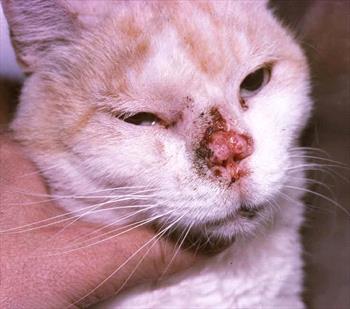Cat with nasal squamous cell carcinoma

This cat has a nasal squamous cell carcinoma. Photo used with permission from Dr. Barbara Stein.
There isn't really any good way to get a squamous cell carcinoma. The tumor is locally destructive and spreads aggressively in the area where it has arisen. That said, there are some circumstances where it is possible to either cure or achieve meaningful control of this tumor, and the nasal form is one of these situations.
The squamous cell carcinoma is associated with sun exposure, and this means that lesions on the white-furred areas of the feline face are at risk. The ear tips and nose are particularly vulnerable, as one might expect, as these areas are not well-protected by fur.
The squamous cell carcinoma begins as a small scabby area that may not attract much attention as it can be mistaken for a minor abrasion. This minor abrasion, however, does not heal and continues to get larger.
Because squamous cell carcinoma does not spread distantly in the body until late in its course, this provides a window during which it can be successfully treated. Once it gets too big, that window has closed even if the tumor has not yet spread.
Surgical Treatment
If the tumor is not too big, surgical removal is curative. That said, squamous cell carcinoma is invasive, so a wide margin of normal tissue must be excised in order to get the whole tumor. If the tumor has been allowed to grow too large, there will not be enough tissue to get a good margin around it, and it will regrow, resuming its destructive course.
The surgery is ideally done with laser equipment to reduce bleeding; it is probably best to seek the skills of a surgery specialist or at least a veterinarian with a great deal of facial surgery experience. Discuss with your veterinarian whether or not a referral to a specialist is in the best interest of you and your pet.
The leather of the nose is removed along with some of the surrounding haired skin. The nasal opening will heal cosmetically but will look a little unusual.
Cryotherapy may be less invasive. This involves using a probe to freeze the tumor. Again, this can be curative if the tumor is small enough, but in freezing the tissue, there is no tissue to send to the lab for analysis. The biopsy (lab analysis) of the tissue not only confirms squamous cell carcinoma but also enables the pathologist to tell if the excision was complete or not. This is valuable information that we would prefer not to forgo for obvious reasons.
Cat after nose leather removal for nasal squamous cell carcinoma

Cat after nose leather removal for nasal squamous cell carcinoma Caption: Image courtesy MarVistaVet
Radiation Therapy
Radiotherapy is rapidly becoming the treatment of choice. Strontium plesiotherapy using strontium 90 involves applying a localized radiation source to the tumor directly for a brief period of time. (Imagine a wand with a radiation source on the end.) Radiation destroys tissue in a 3 mm diameter from the source, which allows for the destruction of small superficial tumors. As with surgery, if the tumor is too big, it cannot be cured.
Alternatively, external radiation beams can be aimed at the tumor under general anesthesia. In one study, 60 percent of irradiated cats had a complete response, and 33 percent had a partial response.
Radiation therapy obviously requires specialized equipment that is usually found only in specialty facilities. It is not available everywhere. A consultation with a veterinary oncologist will help determine if a given patient is a good candidate and what is involved in finding the nearest radiofacility.
Imiquimod 5% Creme
Imiquimod is an immunity-modifying topical crème that is palliative for tumors too large for curative removal or to treat the more superficial form of squamous cell carcinoma called Bowenoid carcinoma or squamous cell carcinoma in situ. Imiquimod is a relatively expensive product, and an upset stomach can result if the crème is licked (which it inevitably would be).
Other Ideas
You may not know the term "cyclooxygenase," but you are probably familiar with human anti-inflammatory cyclooxygenase inhibitors like aspirin, ibuprofen (Advil®), naproxen (Aleve®), and others. While these human anti-inflammatories are not safe for cats, there are some that are. This comes into play here because there is some thinking that carcinomas express enough cyclooxygenase that a feline-friendly non-steroidal anti-inflammatory pain reliever (such as piroxicam, meloxicam, or robenacoxib) may have anti-tumor effects. These medications are not completely without issues but may be helpful when other treatments are not an option, especially since they offer some pain relief.
Even though squamous cell carcinoma does not spread until relatively late in its course, it is still extremely difficult to address. The nasal version is an exception to the poor prognosis rule as long as it is detected early and removed or irradiated promptly.